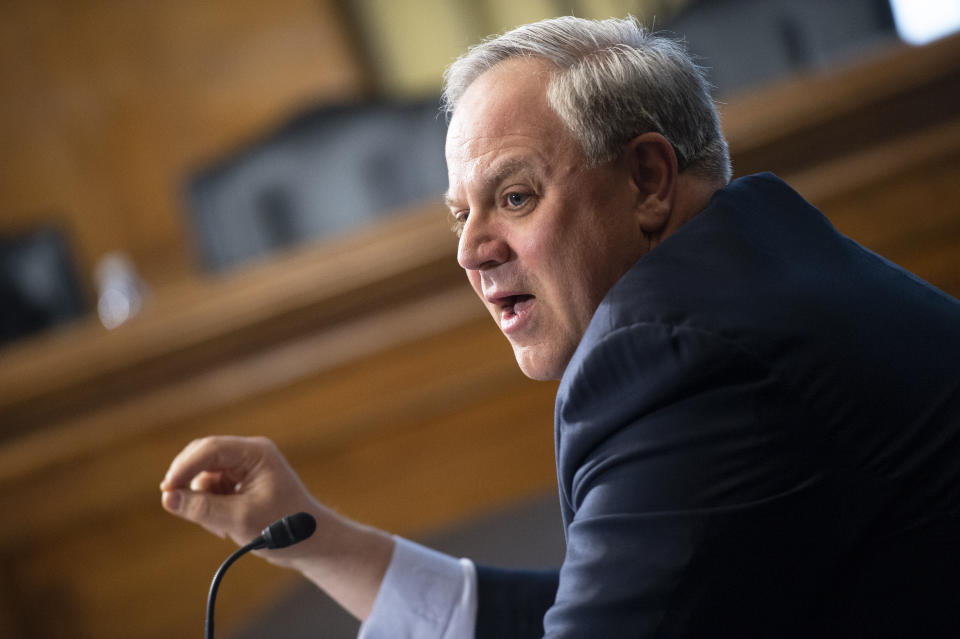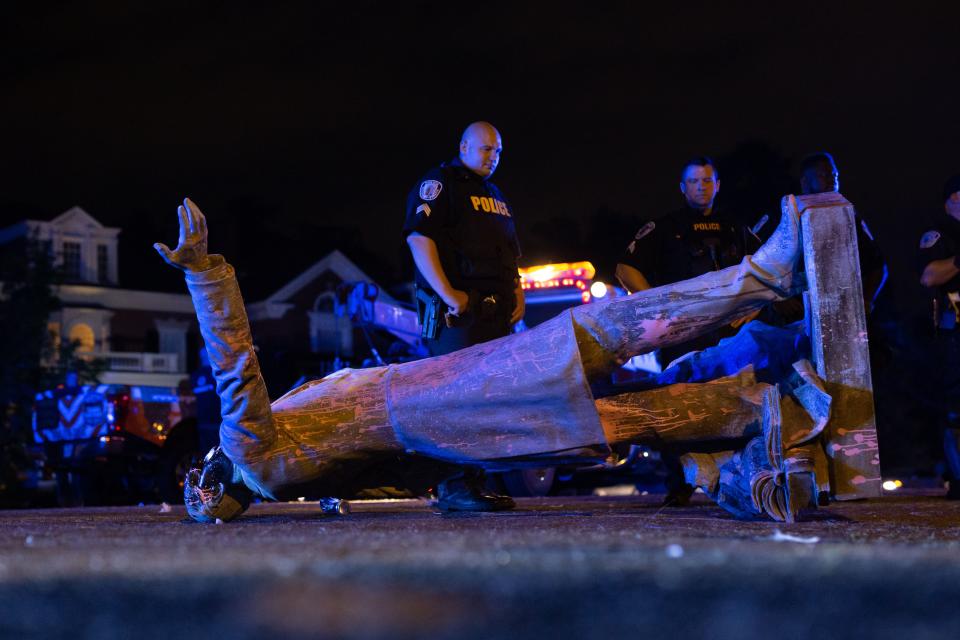Interior secretary calls Confederate statue protesters 'bad-doers,' confirms feds are monitoring their social media feeds
WASHINGTON — 1130 WISN is a conservative talk radio station in southeastern Wisconsin and, by dint of its reach, is not a regular stop for high-level White House officials. But as it happens, southeastern Wisconsin’s swing counties, which voted for Donald Trump in 2016, are critical for his reelection chances.
Which may explain why late last week, Interior Secretary David Bernhardt appeared on the 1130 WISN talk show of conservative commentator Vicki McKenna to discuss an issue seemingly unrelated to local concerns: the tearing down of Confederate and other statues by antiracism protesters. The president believes that preserving those statues could be a potent campaign message, and Bernhardt was reinforcing that message in a state where Confederate imagery is scant.

That hardly mattered to Bernhardt, who condemned protesters for “destroying everything that America holds dear,” describing them as “unified in the message of destruction.” He made no distinction between those who had legitimate concerns with Confederate iconography and those who vandalized statues or memorials that had no obvious connection to the history of American racism.
“You erase somebody’s history,” McKenna said at one point, “and all of the great things that are about this country, a generation or two from now, are now gone.”
Bernhardt also confirmed that federal authorities were monitoring social media postings from the protests, potentially in order to arrest people defacing or vandalizing government property.
“The bad-doers are great,” Bernhardt said at one point, speaking with obvious sarcasm. “They’re really great at posting their actions on Facebook or utilizing their camera. And that’s great in one way, but it’s not great for them when we come to get ’em.”
Civil libertarians have long worried about law enforcement agencies monitoring social media. Such monitoring has been facilitated by the ubiquity of smartphones at the protests that followed the killing of George Floyd by Minneapolis police officers, and the widespread use of social media by attendees and organizers of those protests.
The Interior Department did not answer detailed questions about Bernhardt’s description of such surveillance. “The Secretary’s interview speaks for itself,” department spokesman Benjamin Goldey told Yahoo News. After the story was published, the Interior Department’s communications office responded on Twitter. “If a criminal commits a federal crime and posts photos about it on their social media, it will be used to hold them accountable,” the message said. “Play stupid games, win stupid prizes.”
In July, the legal blog Lawfare reported on a Department of Homeland Security memorandum that authorized “expanded intelligence activities necessary to mitigate the significant threat” from protests in many American cities that sometimes turned violent. That directive was intended for the DHS Office of Intelligence & Analysis. It is not clear whether Bernhardt was referring to that program or another.
“We are at a point now where we’re rounding these people up,” Bernhardt continued, going on to describe how some protesters were supposedly turning themselves in ahead of being apprehended. The protesters, he claimed, “are actually beginning to just simply call and say, ‘Hey, I’m on my way,’ because they’re realizing that we’re not messing around.”
The appearance on McKenna’s program followed closely what appeared to be Bernhardt’s first appearance as a Trump Cabinet member on Fox News, during which he echoed the president’s tough rhetoric on the protesters. He did the same in an interview with Matt Schlapp, president of the American Conservative Union, to whom the secretary described how the Trump administration was “coming down hard” on protesters.

In his combative condemnation of protesters, Bernhardt was wading into the culture wars with a zeal that does not ordinarily attach to the role of interior secretary. But these are extraordinary times, and since Bernhardt happens to be the federal official in charge of public lands, national parks in particular, he can effectively campaign for Trump while claiming to do agency work.
Until this summer’s protests, the 50-year-old former lobbyist had kept a meticulously low profile and rarely made news. But one would hardly guess as much from his conversation with McKenna, the Wisconsin radio host.
“This goes to the very fabric of our historical soul,” Bernhardt told the host. He called the protests “an assault on our history, and on us.” He did not say who “us” referred to, or address the argument that images of Confederate generals like Robert E. Lee glorify slavery and make Black Americans feel like second-class citizens.
“And the president gets it,” Bernhardt added. “He’s leaning way into this.”
Bernhardt’s agency not only controls both national parks and vast open spaces across the West that are managed by the Bureau of Land Management, but also oversees the U.S. Park Police. Members of that force were involved with the much-criticized clearing of peaceful protesters from Lafayette Square, across from the White House.
In the two months since the Lafayette Square incident, Bernhardt has adopted an increasingly vocal law-and-order persona, one that seems to fit more closely with Trump’s political imperatives than with the mission of the Department of Interior, which also controls the Bureau of Indian Affairs and the U.S Geological Survey, among other agencies.
There are, by one count, 233 memorials dedicated to the Confederacy at sites administered by the National Park Service, including at the famed battlefields of Gettysburg and Antietam. And if Trump and Bernhardt have their way, they aren’t going anywhere.
“They know we are not messing around, we are not accepting this,” Bernhardt told McKenna during the interview. “And we’re going to put these guys in jail.”
Most Americans still believe that Confederate statues should not be moved or destroyed, according to recent polling, but support for symbols of the South has recently been eroding. In July, Mississippi decided to change its state flag, which contains the “stars and bars” symbol most commonly associated with the Confederacy. The Pentagon has also prohibited the Confederate flag, along with other flags, from being flown at its bases. Confederate flags are also no longer welcome at NASCAR events.

Jayson O’Neill, executive director of the Western Values Project, told Yahoo News that Bernhardt should be thinking about how to protect national parks in the midst of a pandemic instead of appearing on “a hypocritical right-wing talk show trying to rewrite history.”
Trump has sought to turn the fate of Confederate symbols into a campaign issue, denouncing moves like the one NASCAR made. He has maintained that “beautiful statues” honoring the South — many of which were actually mass-produced in the North — must remain standing where they are, making no evident concessions to the antiracism protesters or their demands.
A native of rural western Colorado, Bernhardt does not appear to be a natural culture warrior, having worked in mainstream conservative politics for decades. And yet he has eagerly embraced the role. And though he is hardly a long-standing ally of Trump, the president did single him out for praise at a rally in Colorado shortly before the coronavirus pandemic shut down the nation. Bernhardt, the president mused, was a “nice, slim, beautiful-looking man.”
“He looks beautiful,” Trump added for emphasis as some in the audience laughed.
_____
Read more from Yahoo News:

 Yahoo News
Yahoo News 

